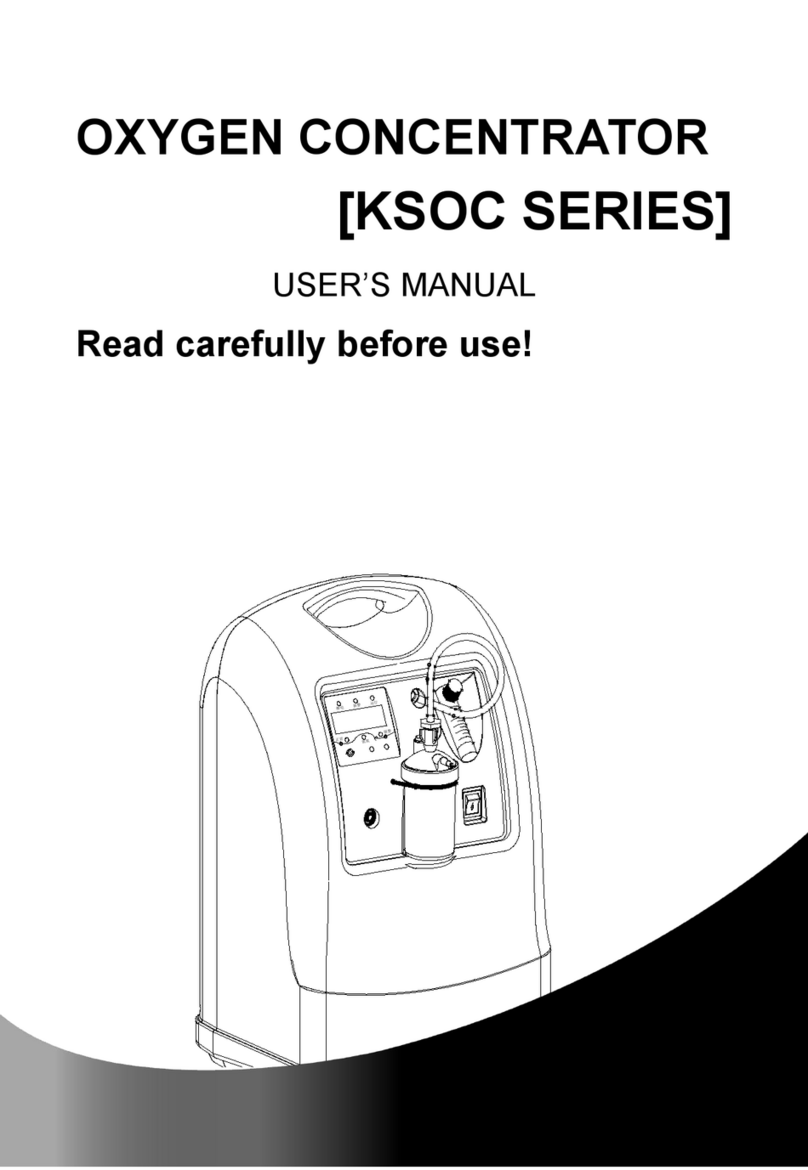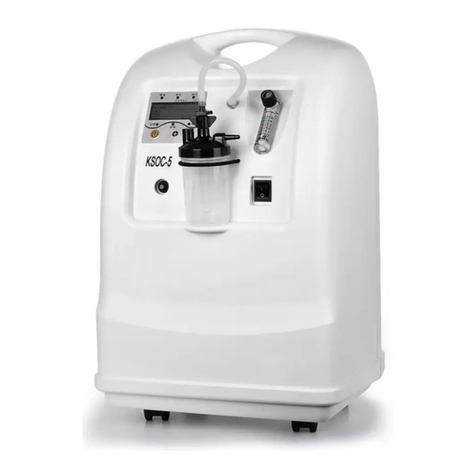
Fingertip Pulse Oximeter
User Manual
Jiangsu Konsung Bio-Medical Science And Technology Co., Ltd
Jiangsu Konsung Bio-Medical Science And Technology
Co., Ltd
NO.8, Shengchang West Road, Danyang
Development Zone, Jiangsu Province, 212300,
P.R. China
Tel: 86-511-86375968
WhatsApp:0086-18952012596
E-mail: info@ konsung.com
Website: www.konsungmedical.com
Shanghai International Holding Corp. GmbH
(Europe)
Eiffestrasse 80, 20537 Hamburg Germany
Tel: +49-40-2513175 Fax: +49-40-255726
E-mail: shholding@hotmail.com
Statement
Thanks for your purchasing Fingertip oximeter of Jiangsu Konsung Bio-
Medical Science And Technology Co., Ltd. (hereinafter called Konsung).
Before using this oximeter, please read this manual carefully for
understanding the operation and maintenance of the oximeter.
Konsung holds the rights to modify, update, and ultimately explain this
manual.
Konsung owns the copyrights of this manual. Without prior written
consent of Konsung, any materials contained in this manual shall not be
photocopied, reproduced or translated into other languages.
Materials protected by the copyright law, including but not limited to
confidential information such as technical information and patent
information are contained in this manual, the user shall not disclose such
information to any irrelevant third party.
This manual will help you understand the operation and maintenance of
the product better. It is reminded that the product shall be used strictly
complying with this manual. User‘s operation failing to comply with this
manual may result in malfunction or accident for which Konsung cannot
be held liable.
Fingertip Pulse Oximeter is Class 1 LEDs product. It must be serviced by
specified trained personnel.
Responsibility of the Manufacturer
Konsung only considers itself responsible for any effect on safety,
reliability and performance of the equipment if:
Assembly operations, extensions, re-adjustments, modifications or
repairs are carried out by persons authorized by Konsung, and
The electrical installation of the relevant room complies with national
standards, and
The instrument is used in accordance with the instructions for use.
Upon request, Konsung may provide, with compensation, necessary
circuit diagrams, and other information to help qualified technician to
maintain and repair some parts, which Konsung may define as user
serviceable.
Chapter 1 Safety
1.1 Safety Information
The user should pay attention to and abide by the basic safety
information which was referred to in this chapter.
WARNING
AWARNING label advises against certain actions or situations
that could result in personal injury or death.
CAUTION
ACAUTION label advises against actions or situations that
could damage equipment, produce inaccurate data, or
invalidate a procedure.
NOTE
ANOTE provides useful information regarding a function or a
procedure.
WARNING
1 This device is not intended for treatment.
2 Carefully read this manual about all safety information, operation
and specifications before using this oximeter.
3 Do not open the shell of the instrument. Otherwise you may
damage the instrument. All servicing and future upgrades must be
carried out by the personnel trained and authorized by our company
only.
4 Do not use this device with the defibrillator or other high-frequency
equipment.
5 Explosion hazard: Do not use this device in an explosive atmosphere.
6 Check and change the applied site according to the different
circumstances of the user while using this device for long-time
continuous monitoring. It is recommended to check the finger after
2 hours. Change other finger to be measured if the finger seems to
be unusual. If the oximeter is too tight because the application site
is too large or becomes too large due to edema, excessive pressure
for prolonged periods may result in venous congestion distal from
the application site, leading to interstitial edema and tissue
ischemia.
7 The measuring data displayed on the device are for reference only
and cannot be directly used for diagnostic interpretation.
8 This device is not intended to use of infant and neonate.
9 In some circumstances, the device may interpret motion as good
pulse quality. Minimize patient motion as much as possible.
10 The presence of high ambient light may cause inaccurate SpO2
measurements.
11 Charge this device only by connecting it to a designated device
compliant with IEC60601-1 requirements of electrical safety and
ensure the designated device’s voltage and current meet the
requirements of this Manual.
12 Do not connect it to any external device or operate it for
measurement when this device is being charged.
13 Do not use this device in situations where alarms required. The
oximeter does not support alarms.
14 Users who are allergic to rubber cannot use this product.
15 Disposal of this device and its accessories and packaging (plastic
bags, foam and cartons, etc.) are subject to local laws and
regulations.
CAUTION
1 To ensure patient safety, use only parts and accessories specified in
this manual.
2 Keep the operating environment clean, no vibration, no corrosion
or combustible material and avoid too high or too low temperature
and humidity.
3 Do not use this device near by the source of electromagnetic
interference, such as mobile phones or radio transmitter.
4 Do not spill liquid on the device. Do not immerse the device in
liquid.
5 Always install or carry the device properly to avoid damage caused
by drop, impact, strong vibration or other mechanical force.
6 Do not use this device if the device cannot achieve satisfactory
results.
NOTE
1 Too cold or too thin finger may affect the measurements; thicker
finger (recommended thumb or middle finger) should insert into the
cover fully.
2 Avoid placing the sensor on extremities with an arterial catheter, or
intravascular venous infusion line.
3 Check the device before using. Do not use it if there is significant
damage.
4 Do not use the functional tester to access the SpO2accuracy.
5 This device is calibrated to display functional oxygen saturation.
6 The pictures and interfaces in this manual are for reference only.
7 This Manual is prepared based on the most complete configuration.
Some configurations and functions may be not available in your
device.
8 Fingernail polish or false fingernails may cause inaccurate SpO2
readings.
1.2 Symbols
Follow instructions for use
Oxygen saturation of arterial hemoglobin
The symbol indicates that the device should be
sent to the special agencies according to local
regulations for separate collection after its useful
life.
The symbol indicates that the device complies with
the European Council Directive 93/42/EEC
concerning medical devices.
Authorized representative in the European
community
2 degree Protection Against Ingress of Liquids and
dust.
Chapter 2 General
2.1 Introduction
Sonosat F fingertip pulse oximeter using spectrophotometry, by
detecting the blood red and infrared absorption of light to obtain
the oxygen saturation (SpO2) and pulse rate (PR).
Oxygen saturation is a term referring to the fraction of oxygen-
saturated hemoglobin (HbO2) relative to total hemoglobin(Hb) in the
blood, that is, the oxygen saturation in the blood, which is an
important physiological parameter of the respiratory and circulatory
system. Many respiratory diseases can cause oxygen saturation
decrease. The body's automatic regulatory dysfunction caused by
anesthesia, major surgery trauma, and injury caused by some
medical examination etc., are likely to lead to the oxygen saturation
decrease, resulting in patients with dizziness, weakness, vomiting
and other symptoms; severe cases will be life-threatening. SpO2 has
important significance in the field of clinical medical. And timely
understanding of the patient's blood oxygen saturation situation will
help physician find problems.
This device is not suitable for continuous monitoring of patients.
2.2 Intended Use and Contraindication
Intended use: The fingertip pulse oximeter is intended to measure the
pulse oxygen saturation of arterial hemoglobin and pulse rate of adults
and pediatrics in home care and medical outpatient environment.
Contraindication: none
2.3 Applications
This device is suitable for the following people: People with
vascular disease, such as: coronary heart disease, hypertension,
hyperlipidemia, cerebral thrombosis;
People with respiratory diseases, such as: asthma, trachitis,
chronic bronchitis, chronic cor pulmonale, chronic obstructive
pulmonary disease;
Old people above 60 years old
People who works more than 12 hours a day;
People works on extreme exercise or under the alpine hypoxic
environment;
Long-term alcohol people.
2.4 Appearance
2.4.1 Front view
1. Battery capacity Indicator
Full capacity, the middle part indicates the
capacity.
Capacity is seriously empty, charge it
immediately.
2. Power On/Off switch
Turn on the oximeter: Press the ON/OFF button to
turn on the device.
Turn off the oximeter: Press this button for 2 seconds
to turn the device off.
Press this button to highlight the display when the
display is in low brightness.
3. Display screen
4. SpO2value
5. PR value: Pulse rate per minute.
6. Bluetooth icon
on: means connected to Bluetooth device
off: means disconnected to Bluetooth device
7. Heart symbol
8. Pulse rate bar graph
2.4.2 Side view
1. Micro USB connector: charging battery with specified
charging cable connected to adaptor.
2. Rubber finger cover
Chapter 3 Unpacking and Storage
3.1 Open-case inspection
Before unpacking, examine the packing case carefully for
signs of damage. If any damage is detected, contact the
carrier or us. Take out all bulk packaging from the carton. If
the packing case is intact, open the package and remove the
equipment and accessories carefully.
Check whether there is any damage to the surface of the
oximeter such as notches, dents, abrasions and so on. Check
whether the components are missing according to packing
list.
3.2 Storage
The oximeter is manufactured with precision parts. Do not
place the oximeter in the following places:
Easy to splash;
With Direct sunlight, high temperature, humidity, dust,
and corrosive gas;
Tilt, generate vibration and impact;
Store chemicals or corrosive gases.
Chapter 4 Measurement operation
1. Insert finger to oximeter's cover fully to obtain good
measurements.
2. Press the ON/OFF button to turn the oximeter on.
3. SpO2and pulse rate value displays on screen.
NOTE:
1 The oximeter cannot be measured while charging.
2 Finger can not apply nail polish and other cosmetics.
3 Do not shake the finger, hand or body during the measuring.
4 Tape or other light obstructions around the applied site may
affect the accuracy of SpO2and pulse rate.
5 The oximeter will shut down if no any actions within 10
seconds after it turning on.
The following factors may influence the accuracy of measurement:
Ambient light
Physical movement (passive and imposed motion)
Diagnostic testing
Low perfusion
Electromagnetic interference, such as MRI environment
Electrosurgical units
Dysfunctional haemoglobin, such as carboxyhemoglobin
(COHb)and methemoglobin (MetHb)
Presence of certain dyes, such as methylene and indigo
carmine
Inappropriate positioning of the SpO2sensor, or use of
incorrect SpO2sensor.
Drop of arterial blood flow to immeasurable level caused by
shock, anemia, low temperature or vasoconstrictor.
Chapter 5 Charging Battery
The oximeter uses a built-in non-removable rechargeable
lithium battery. Symbol will flash when battery capacity is
low. Charge the battery according to the following steps.
1. Take out the cable and connect it to oximeter's Micro USB
connector.
2. Plug the other end of cable to USB adaptor. Battery
symbol appear and flashes on the screen while charging.
The performance of the rechargeable lithium battery may
deteriorate over time. If the operating time of the battery is
noticeably shorter than that stated in the specifications,
contact your service personnel.
Follow the appropriate local regulations and do not dispose of
oximeter (includes battery).





























